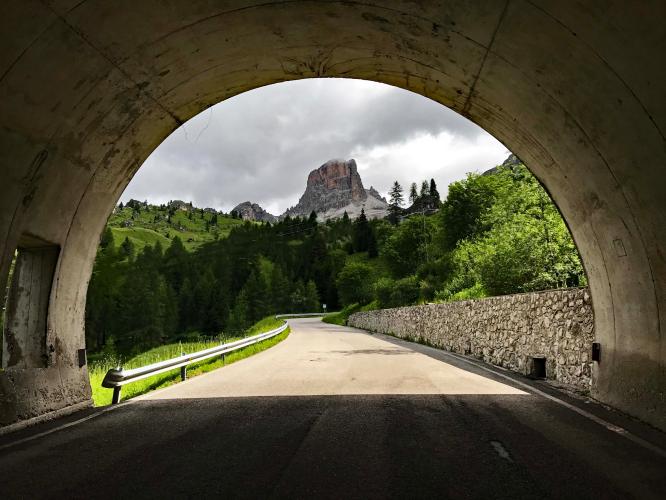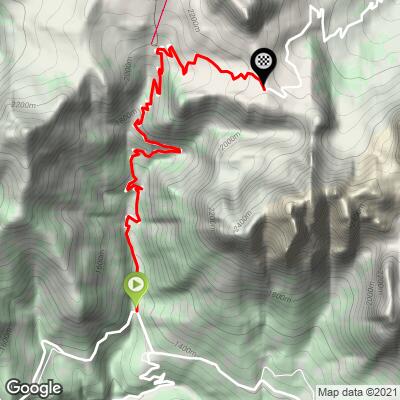![]()
Passo Giau from the south (Codalonga).
Ride 9.6 kilometers gaining 898 meters at 9.4% average grade.
PJAMM Cycling’s 2021 Giro d’Italia page.
The Giro has visited Passo Giau seven times, the earliest as far as we can tell in 1973, and most recently in 2016. Regardless of its Giro tradition, this climb sells itself -- it is one of the most beautiful cycling climbs in the world, and few who have been there would debate this claim.
![]()
Stunning scenery along the climb.
The Giro will again feature Passo Giau on May 16, 2021 as the final climb of the Queen Stage.
![]()
Stage 16 Profile - girodiitalia.it
![]()
Passo Giau Profile - girodiitalia.it
“A fast-running descent through Arabba and up to Selva di Cadore leads to the foot of Passo Giau, where the road ascends at nearly 10% for 10 km. The route then drops towards Cortina, heading for the finish.
Final kilometres.” girodiitalia.it
![]()
PJAMM Cycling’s Profile Tool
61% of the climb is at 5-10% and 36.6% at 10-15%.
At 9.6 kilometers and 9.4% average grade, Passo Giau does offer a fair amount of challenge to the scenic splendor of the climb. Passo Giau from the south is also the most difficult climb in the Dolomites with a respectable Fiets Index of 9.6.
![]()
Thick forest and green hills are seen along much of the climb.
We ride towards, and ultimately past, the famed Monte Averau the majority of the climb. Similar to the great Mont Venoux’s radio tower, it is not often that we have the great fortune of climbing within sight of an iconic formation for the majority of a bicycle climb.
![]()
Monte Averau
The highest mountain of the Dolomites Nuvolau Group at 2649 meters.
This mountain lies between Passo Falzarego and Passo Giau.
The pass itself lies at the base of Nuvolau Massif, which is one of the most renowned formations in the Dolomites.
![]()
Along the climb, a sign marks each of the 29 south ascent tornanti (hairpins).
Both sides of Passo Giau are fairly short and mild by Italian road bike climb standards. The northern approach is 5.4 miles, 2,350’ at 8.2%, and the southern approach is 6 miles, 2,940’ at 9.4%. The steepest sections from the south are: 11.1% for a ¼ mile, 10.55% for ½ a mile, and 10.2% for 1 mile, and the steepest sections from the north are: 10.8% for a ¼ of a mile, 10.1 for a ½ mile, and 9.9% for a mile.
Each approach to Passo Giau showcases what the Dolomites have to offer, that is, extreme and unparalleled beauty in the form of extraordinary and breathtaking mountain and rock formations. Passo Giau (and its Dolomite neighbor Passo Poroi) is truly a bucket list set of climbs that are well worth travelling from, say, for example, Northern California (USA) to do -- and we are glad we included this pass in our 2017 six country, 55 climb European Climb Trip -- it may very well have been the greatest experience of the trip.
![IMG_2521.JPG]()
Kilometer signs keep us company along the way.
![IMG_2652.JPG]()
Cafe at the summit.
![]()
This is an extremely popular cycling destination.
The Giro d’Italia has featured Passo Giau ten times between 1973 and 2018. Most recently, Passo Giau was included in Stage 14 of the 2018 Giro. This inclusion featured six passes climbed, for a “total rise and drop of 4,700 m (out of 5,400)” in a route that “runs across the Val Cordevole along well-surfaced roads, all the way to Arabba.” From there, the route “clears Passo Pordoi, followed by Passo Sella and Passo Gardena (with not even a single flat metre in between), and heads for the first pass over the finish line in Corvara (intermediate sprint). The road then climbs up Passo Campolongo, Passo Giau (the harshest climb of the stage, with an average 9% gradients, and peaks of more than 10-12% over the first kilometres) and Passo Valparola, which leads to the final 5 km” (Giroditalia).
Passo Giau has been the Cima Coppi of the Giro twice since that designation was first introduced in 1965 to honor arguably the Giro’s greatest participant of all time:
“The Cima Coppi is the title given to the highest peak in the yearly running of the Giro d'Italia, one of cycling's Grand Tour races. The mountain that is given this title each year awards more mountains classification points to the first rider than any of the other categorized mountains in the race.
The categorization was first introduced for the 1965 Giro d'Italia in honor of the late Fausto Coppi who won five editions of the Giro d'Italia and three mountain classification titles during his career. It was first announced on 22 April 1965 by then race director Vicenzo Torriani that the highest peak would award two times as many mountains classification points. Torriani thought of possibly awarding time bonuses to the first to summit the mountain; however, after many dissenting opinions, he opted to go award more mountains classification points.
The Cima Coppi changes from year to year, depending on the altitude profile of the Giro d'Italia, but the Cima Coppi par excellence is the Stelvio Pass, which at 2758 m is the highest point ever reached by the Giro. The Stelvio has been used in the 1972, 1975, 1980, 1994, 2005, 2012, 2014 and 2017 editions. It was also scheduled in 1965, 1988, and 2013, but in each case the course was modified due to weather conditions, with various effects on the Cima Coppi designation” (Wikipedia - Cima Coppi).

 We've partnered with Sherpa-Map.com to bring you the best route planning tool. With a PRO Membership you can use this climb as a reference when creating your route.
We've partnered with Sherpa-Map.com to bring you the best route planning tool. With a PRO Membership you can use this climb as a reference when creating your route. 

